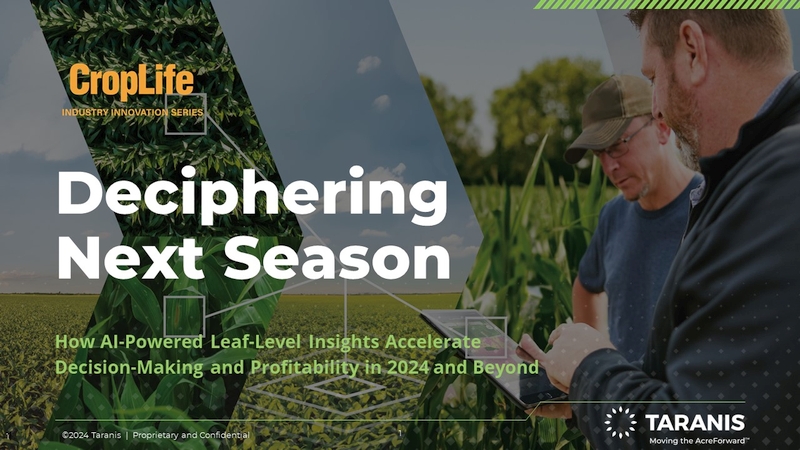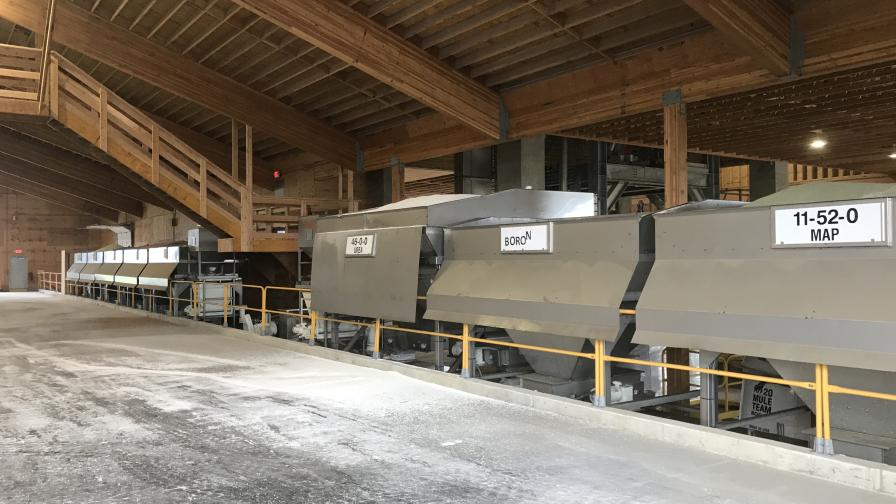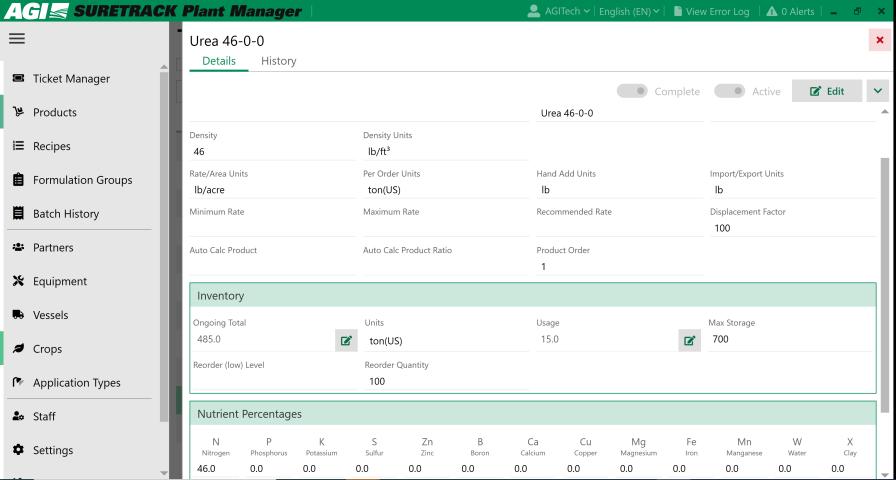Efficiency Through Automation: A Look at Fertilizer Mixing and Blending Systems in 2021
Nearly every area of agriculture — every area of society — has seen change in the form of increased automation and advanced technology. Mixing and blending systems are no different.
“AGI Fertilizer blending systems continue to incorporate technological advances in materials, manufacturing, and software innovations,” says Jason Boyles, North American Sales Manager, AGI Yargus. “These improvements allow our systems to be run with less manpower, more accurately, and with data collection way beyond the capabilities of yesterday.”
As crop input technology has advanced, the machinery used to spread those inputs has had march in lock step.
“The proliferation of micronutrients and the automation required to blend this material accurately is one of the larger challenges faced by the industry,” Boyles says. AGI Suretrack Plant Manager software provides the ability to tie fertilizer blend systems with vehicle tracking, ERP Systems, and agribusiness software. This is the most significant of the improvements in the last decade.”
Murray Equipment Inc. (MEI) agrees.
“For many years, blending systems were primarily about the equipment — what is the best equipment for the application,” says Todd Scobie, MEI’s Sales & Marketing Manager. “While equipment is still a focal point, in the past 20 years it’s become increasingly about the automation and real-time inventory management. Murray equipment is using automation to produce more products in a single blender and allow for precise sequencing control to produce more product quickly, safely, without having to stop production.”
While several factors go into making purchasing decisions, there are two that rank at the top, according to Dan Murray, President, ICS, which handles the automation side of Murray Equipment’s blending systems.
“As growers are adopting more efficient business practices, they’re demanding speed and responsiveness from their retailers,” Murray says. “ICS controls not only speed up load times but also streamline billing and reduce errors. This provides a much better customer experience. Additionally, retailers and wholesalers can keep a close eye on inventory levels to ensure they have enough product on-hand at the right locations to meet customer demand.”
Simply put. it’s about reducing errors and increasing efficiency.
“The demands of dry fertilizer blending systems haven’t changed significantly over the years, they’ve just been amplified,” says Nate Wittmaack, President/COO, Ranco. “There has always been a desire to go faster, be accurate, remove human error, and eliminate breakdowns. That said, as growers get larger, agronomic products become more numerous, and blend plants cover more ground, the need for speed and accuracy has increased at an increasing rate.
2020 Challenges
“Outside of the obvious manpower and HR issues created by COVID, the most significant impact has been the way the industry addressed maintenance issues,” Boyles says. “Our ability to remotely support the Yargus/Junge Control systems through AGI Suretrack Plant Manager is becoming increasingly more essential.”
Despite what a slowdown that affected many industries, agriculture was largely deemed essential, which minimized disruptions and help keep many farm equipment manufacturers busy.
“During 2020 we continued to experience an increase in demand. We did have some interesting supply challenges this year,” Scobie says. “Fortunately, Murray Equipment’s strong industry relationships allowed us to keep our customers up and running while building many new facilities as well.”
ICS had a similar experience.
“We’ve actually experienced an increase in demand,” Murray says. “Automated blending systems facilitate social distancing. Loads are completed faster. Transactions are handled electronically. Equipment can be controlled remotely. In addition, fully automated blending facilities offer exceptional ROI — real-time inventory management, improved safety, increased customer satisfaction, and most often business growth.”
Ranco’s Wittmaack was a bit less enthusiastic about 2020, but still the company had a busy year.
“There was certainly some pull back from an otherwise positively trending industry,” Wittmaack says. “Multiple projects were either put on hold or mothballed all together. Thankfully, regardless of a pandemic, growers are going to grow. This means that we needed to keep rolling to not only support the new projects we had committed to, but also servicing our existing customers’ needs.”
There were (and will continue to be) a few obstacles.
“As growers consolidate and demand higher response times from retailers, it’s companies with fast and efficient blending facilities along with good customer service practices that will stand out,” Scobie says. “The challenge for retailers is anticipating growth and demand and making sure they’ve got the equipment in place to meet that demand.”
It’s the pace of change that keeps the team at ICS focused on continuous innovation.
“Thanks to software, innovations to blending systems are happening more rapidly,” Murray says. “The challenge is systems are aging more quickly. With ICS ControlPro, we can send out updates to extend the lifetime of their investment, to ensure our retailers continue to have a competitive edge. But more importantly this allows them to continually offer better service to their growers.”
2021 and Beyond
“We expect the use of technology for precise blends and data collection will continue to be more closely coupled with operations management systems,” Boyles says. “This will necessitate the demand for these systems to be updated quarterly with subscription-based model, so they are at optimum performance at all times, therefore changing the way we approach service agreements. “
Murray Equipment’s Scobie is hopeful about the next few years.
“We expect to continue to see an increase in demand,” Scobie says. “The ROI we can provide when replacing aging facilities and the strategic advantage we can offer to retailers looking to expand their reach, makes new blending facilities an easy decision.”
The expectations for a strong 2021 and beyond seems to be universal.
“Based on the strengthening we believed to be happening pre-pandemic, and the industry signs over the latter portion of 2020, we believe that 2021 will be an “up” year in terms of dry fertilizer blending and handling infrastructure,” Wittmaack says.
Feature Rich
“Today’s retailers are looking for every edge possible,” Boyles says. “We are seeing the expectation for a well-engineered, easy to maintain, turnkey systems the essential need of our customer base. Utilizing our world-class engineering team, global manufacturing footprint, and product development capabilities in automation software is allowing our customer to maintain a competitive advantage.
“AGI Fertilizer Systems focuses on efficiency through automation,” Boyles continues. “With a team of more than 12 mechanical engineers, and 14 software and controls engineer we continue to lead the way with product innovations as the needs of the industry change with future breakthroughs in the agronomic industry.”
Even though the COVID-19 pandemic put a halt to most in-person events, preventing growers seeing their latest offerings, that doesn’t mean manufacturers sat by idly.
“Automation is becoming standard,” Murray says. “Since innovations are happening daily, we believe we’ll see a transition to controls, like our ICS controls, that can be updated online to add in new functionality. This is a departure from completely replacing software and controls to update the automation. ICS software can be deployed on tablets to allow safe and efficient control of equipment. It’s done via an app so that doesn’t matter if the device is Android, Apple or Windows.”
Of course, innovation doesn’t happen in a vacuum. Manufacturers look for their inspiration from who else — the end user.
“We have been surveying our customers to learn how we can best continue to grow our footprint inside of this industry,” Wittmaack says. “We believe that there may be opportunities for new product development to provide additional growth opportunities inside this segment.”
Driving Decisions
“Aging facilities, strategic growth plans, and efficiency are why retailers approach us to build new systems,” Scobie says. “Why they approach MEI in particular is our deep industry experience with and understanding of both equipment and automation.”
It’s about value and ROI.
“Speed, customer service, safety, and inventory management are the primary drivers for new systems,” Murray says. “Customers want to serve their growers better, while lowering costs, and improving safety.”
Ranco’s Wittmaack agrees.
“By in large, the factors of influence for purchasing/upgrading blend systems is no different than many decisions that we all make on a day-to-day basis,” Wittmaack says. “First, can we be confident that we are purchasing value? This does not mean least or most expensive, but most value. For us, being able to offer quality equipment and the dedication to back it up with a full installation and service department helps provide value. Secondly, at least a portion of every decision comes down to relationships. Relationship selling does not mean compromising value, it should supplement the value. Catalog selling is easy, but to provide systems that fit the customer need, a relationship based on open communication and shared understanding has to be created. This relationship instills confidence on the side of the buyer, and commitment on the part of the seller.”
Company News
• AGI Yargus. The company’s capability to blend the smallest of blends through customized and modular declining weight blend centers, or precision liquid weigh systems allows AGI Yargus to provide a complete design for any liquid or dry fertilizer facility whether you operate in a wholesale or retail environment.
• Murray Equipment/ICS. Tablets, sequencing control, improved inventory control, online support, and update deployment. MEI pairs the latest control and automation software with unique equipment and plumbing designs to provide speed, efficiency and accuracy. The company can save time by using one scale instead of two for custody transfer, or it can set-up valve and meter control schemes for increased batching and sequencing to reduce control downtime between blends.
• Ranco/ICS. The company rolled out our MeshDCS blend system in early 2020. The MeshDCS system is a Distributed Controls System. The Ranco Declining Weigh blend system has been the premier continuous blending system on the market since it was introduced in 2000. But the MeshDCS is the current generation that will significantly reduce the field wiring requirements and local electrician costs associated with putting in a new system. Also, the company has spent a lot of time over the last seven years building out our ability to supply industry leading automation and integration services with the equipment systems we sell. Automation has become a big push over the last decade, and Ranco is proud to have provided integration and automation services to the biggest customers in our industry, both domestically and internationally.








